
The Savio is a river in the Emilia-Romagna region of northern Italy. Its source is in the province of Forlì-Cesena near Montecoronaro on Mount Castelvecchio which is near the western side of Mount Fumaiolo. The source is at an elevation of 1,126 metres (3,694 ft) and is marked by an iron monument. A wolf and the rings of the caveja are on this monument. The river flows near Verghereto and Bagno di Romagna as it winds through the mountains before entering Lago di Quarto. After leaving the lake, the river flows northeast near Sarsina and Mercato Saraceno before flowing north. The river winds for 96 kilometres (60 mi) along the valley. Its natural track has been preserved relatively well and, in the territory of Cesena, it shows an environment which is one of the purest of the whole Romagna. North of Cesena, the river crosses the border into the province of Ravenna. After a total course of 126 kilometres (78 mi) the river enters the Adriatic Sea north of Cervia by Lido di Classe and Lido di Savio.
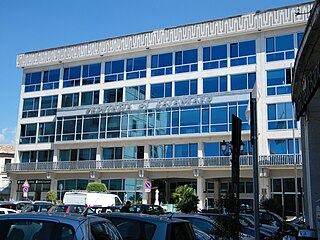
The province of Catanzaro is a province of the Calabria region of Italy. The city Catanzaro is both capital of the province and capital of the region of Calabria. The province contains 80 comuni. Its provincial president is Sergio Abramo.

The province of Crotone is a province in the Calabria region of Italy. It was formed in 1992 out of a section of the province of Catanzaro. The provincial capital is the city of Crotone. It borders the provinces of Cosenza, Catanzaro, and also the Ionian Sea. It contains the mountain Pizzuta, the National Park of the Sila, Montagnella Park, and the Giglietto Valley. Crotone was founded in 710 BCE. It participated in the Second Punic War against the Roman Republic.

The Agri is a river in the Basilicata region of southern Italy. In ancient times it was known as Aciris. The source of the river is in the Lucan Apennines north of Monte Volturino and west of Calvello in the province of Potenza. It is near the source of the Basento. The river flows south near Paterno before curving southeast. It flows near Tramutola, Viggiano, and Grumento Nova before entering a lake. After exiting the lake, the river flows eastward near Armento, Missanello, Aliano, and Sant'Arcangelo. A right tributary, the Racanello, enters the river in this area. The river forms the border between the province of Potenza and the province of Matera for part of this area of the river. It flows into a small lake before entering the province of Matera. The river flows for a short distance before entering Lago di Gannano. After exiting the lake, the river flows southeast near Tursi, Montalbano Jonico, and Scanzano Jonico before flowing into the Gulf of Taranto near Policoro.
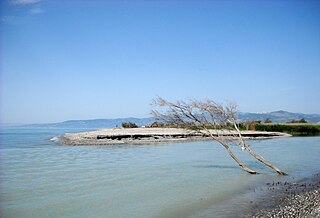
The Sinni is a 94 km long river in the Basilicata region of southern Italy. In antiquity, the city of Siris lay at its mouth. Near the town of Senise, a dam on the river was built in 1970-1982, the largest in Europe built with earth. In correspondence of it, it forms the Lago di Monte Cotugno, one of the largest artificial basins in Italy.

The Spöl or Aqua Granda is an Italian and Swiss river and is a right tributary of the Inn.

The Basento is a river in the Basilicata region of southern Italy. It rises at Monte Arioso in the southern Apennine Mountains, southwest of Potenza in the province of Potenza. The river flows northeast near Pignola and Potenza before curving east near Vaglio Basilicata. It curves southeast and flows near Brindisi Montagna, Trivigno, and Albano di Lucania. A right tributary coming from Lago di Ponte Fontanelle flows into the river in this area. The river forms the border between the province of Potenza and the province of Matera for a short distance before flowing into the province of Matera. It flows eastward near Tricarico, Calciano, and Grassano before curving southeast. The river flows near Grottole, Miglionico, Pomarico, Ferrandina, and Monte Finese before curving eastward. It flows near Pisticci and Bernalda before flowing into the Gulf of Taranto, which is part of the Ionian Sea, near Metaponto. The main city on the Basento is Potenza, the capital of Basilicata.
Lago is a comune in the province of Cosenza, Calabria, in southern Italy. It is located 42 kilometers from the city of Cosenza.

The Cesano is a river in the Marche region of Italy. Its source is near Monte Catria on the border between the province of Perugia and the province of Pesaro e Urbino. The river flows northeast through Pesaro e Urbino before forming the border between Pesaro e Urbino and the province of Ancona for a short distance. It continues flowing northeast through Pesaro e Urbino and flows past Pergola before becoming the border with Ancona again near San Lorenzo in Campo. The river flows northeast near Mondavio, Corinaldo and Monte Porzio before the province of Ancona extends westward beyond the bank of the river for a short distance near Mondolfo. Finally, the river flows into the Adriatic Sea north of Senigallia and south of Marotta and Fano.

The Tronto is a 115-kilometre (71 mi) long Italian river that arises at Monti della Laga and ends in the Adriatic Sea at Porto d'Ascoli, San Benedetto del Tronto. It traverses the Lazio, Marche, and Abruzzo regions of Italy.
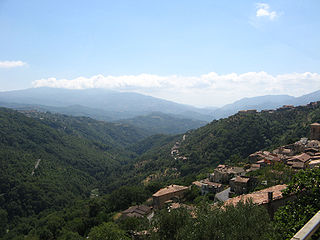
The Savuto is a river and valley in Calabria, Southern Italy, that lies at the intersection of the provinces of Cosenza and Catanzaro. It is also the name of a DOC wine produced in the region.
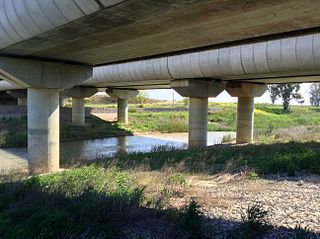
The Bradano is a river in the Basilicata and Apulia regions of southern Italy. Its source is Lago Pesole in the province of Potenza. The river flows southeast near Monte Torretta, Acerenza, and Oppido Lucano. After crossing into the province of Matera, it is joined by a right tributary, the Alvo. The river flows near Irsina before being joined by a left tributary, the Basentello. Shortly after that, it is joined by another right tributary, the Bilioso. The river then enters Lago di San Giuliano. After flowing out of the lake, the Bradano is joined by a left tributary, the Gravina, and flows southeast near Montescaglioso before entering the province of Taranto. It is then joined by a left tributary, the Gravina di Matera, before re-entering the province of Matera after a short distance. The river flows near the border with the province of Taranto before entering the Gulf of Taranto near Lido di Metaponto.

The Conca is a river in the Marche and Emilia-Romagna regions of Italy. Its source is Monte Carpegna, which is in the Montefeltro part of the province of Pesaro e Urbino. The river flows northeast near Macerata Feltria and Mercatino Conca before crossing into the province of Rimini. The river then flows past Morciano di Romagna before entering the Adriatic Sea southeast of Misano Adriatico and northwest of Cattolica.

Lake Barrea, is an artificial lake in the Province of L'Aquila, Abruzzo, Italy. It is located within the National Park of Abruzzo, Lazio and Molise. The Sangro is its inflow and outflow. To its northwest is Villetta Barrea and to its southeast is Alfedena. To its north is Monte Greco.

The Sagittario is a river in Italy. It is located primarily in the province of L'Aquila in the Abruzzo region of southern Italy. The river is the main tributary of the Aterno-Pescara. Its source is located near Parco Nazionale d'Abruzzo, Lazio e Molise and Scanno. The river flows into Lago di Scanno near Scanno and flows out of the lake near Villalago. The portion of the river that enters the lake is known as the Tasso. The Sagittario flows north through the Appennino Abruzzese near Villalago, Bugnara, Sulmona and Pratola Peligna. It enters the Aterno-Pescara near Raiano and Popoli on the border with the province of Pescara.

The Neto is a river in Calabria, southern Italy. It is the second largest river of Calabria after the Crati.

Botte Donato is a mountain in the Calabria region of southern Italy. It is part of the La Sila mountainous plateau and is the highest peak in the range at 1,928 meters in height. The mountain is within Sila National Park and the province of Cosenza. To the north of the mountain are the lakes Lago di Cecita and Lago di Ariamacina and to the south is the lake Lago Arvo.
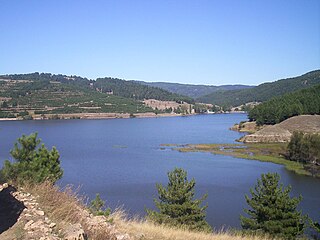
Lago di Ariamacina is a lake in the province of Cosenza, Calabria, southern Italy. It is located in the La Sila range within Sila National Park. The Neto flows into and out of the lake. The lake is a reservoir built between 1953 and 1955 by damming the Neto. Its purpose is to generate hydroelectricity. North of the lake is Lago di Cecita and south of the lake is Lago Arvo.
The Mucone is a river in the province of Cosenza, Calabria, southern Italy. The source of the river is in La Sila north of Botte Donato. It flows into Lago di Cecita and flows out of the lake near the western border of Sila National Park. The river flows northwest before curving west near Acri. It flows near Bisignano before flowing into the Crati east of Torano Castello. The Mucone is the largest right tributary of the Crati.

Lago Arvo is a lake in the province of Cosenza, Calabria, southern Italy. It is located in La Sila east of Aprigliano and west of San Giovanni in Fiore. The lake is south of Lago di Ariamacina and Botte Donato and northwest of Lago Ampollino. The Arvo flows into and out of the lake. The lake is a reservoir built between 1927 and 1931 by damming the Arvo. Its purpose is to generate hydroelectricity.



















